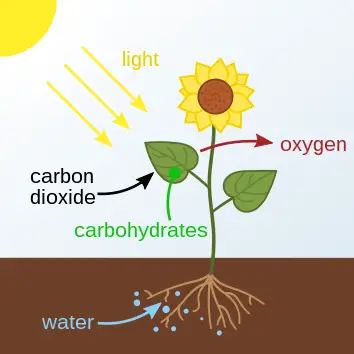9 Disadvantages of Bioenergy Explained
Disadvantages of bioenergy are; low efficiency, deforestation, atmospheric emissions, high cost, food-energy conflict, slow development, resource demands, and seasonality.
This article discusses bioenergy disadvantages, as follows;
1). Low Efficiency (as one of the Disadvantages of Bioenergy)
One of the most prominent disadvantages of bioenergy is its relative low efficiency [3].
Both biomass and processed biofuel have low energy efficiency and energy density compared to fossil fuels.
This implies that, on a volumetric basis, the amount of bioenergy in a unit volume of biomass is less than that which is contained in an equal volume of petroleum.
Also, significant amount of energy is often lost or consumed in the process of extracting and using bioenergy.
Some derivatives of biomass like liquid hydrogen, have high energy efficiency when used in hydrogen fuel cells for electricity generation. However, the extraction, and storage of such derivatives is energy-intensive.
2). Deforestation
While bioenergy is renewable and derived from naturally-occurring organic matter, it is important to use this type of energy in such a manner that ensures sustainability.
The reason for this is that large-scale exploitation of organic matter without equal or extra replenishment can lead to resource depletion and environmental degradation.
One of the common forms of degradation that can occur under such circumstances is deforestation. It is common for plant biomass like wood to be used as feedstock or fuel in a biorefinery [9].
If adequate measures are not taken to replenish vegetation in forests, after they have been harvested as bioenergy feedstock, the natural ecosystem will lose its vegetation with time.
This will have negative effects, like the disruption of natural processes like biodegradation, and the transfer of energy across trophic levels of the energy pyramid. It will also increase the risk of unfavorable environmental conditions desertification, climate change, global warming, heat wave events, and natural hazards.
Because of these potential problems, some studies have suggested that the promotion of bioenergy may not lead to sustainable development, although this is one of the alleged advantages of bioenergy [7].
In order to address such problems that have limited the advancement of bioenergy, various strategies have been developed to reduce the depletion of wood biomass [2].

3). Atmospheric Emissions (as one of the Disadvantages of Bioenergy)
Bioenergy is often described as a ‘carbon-neutral’ or ‘net-zero’ form of energy [10].
These opinions are based on two factors. One is the fact that biomass or organic matter is recycled in nature, meaning that the amount of carbon that is released with bioenergy is likely to be reabsorbed from the atmosphere as organic matter is formed.
The second factor is a comparison between bioenergy or biofuels, and fossil fuels.
While some aspects of these beliefs are true, there are some shortcomings.
When biofuel is burnt, it releases greenhouse gases that include methane and carbon dioxide, as well as toxins and pollutants like carbon monoxide and nitrous oxide, which can affect air quality in a negative manner [11].
These emissions are not always reabsorbed from the atmosphere, because the rate of replenishment of biomass is not always equal to the rate of depletion.
Although the emissions from bioenergy production are less than those from fossil fuels, they are still significant. Waste materials used as feedstock may release methane and unpleasant sulfuric gases, while burning and conversion can both yield gaseous byproducts that are unhealthy for the environment.
4). High Biomass-Conversion Cost
The economic aspects of bioenergy production have a significant impact on the overall value and implementation of this type of energy [1].
Advanced bioenergy production requires the conversion of biomass. Various biomass conversion methods exist, such as anaerobic digestion, pyrolysis, gasification, hydrolysis and fermentation. Often, these methods are classified as waste-to-energy techniques due to their relevance in treating organic waste.
Compared to other renewable energy types like geothermal, solar, wave power, and wind, these conversion methods for producing bioenergy are expensive. What this means is that the cost of operating bioenergy technologies like biorefineries and biomass power plants, is high compared to other renewable energy technologies like solar panels and geothermal power plants.
In cases where feedstock is not available within the vicinity of the bioenergy plant, transport of this feedstock from its location to the point of use, will attract more expenses. Other sources of expenditure include environmental remediation measures to mitigate the impacts of bioenergy production on the environment.
5). Food Crop-and-Feedstock Conflict (as one of the Disadvantages of Bioenergy)
It is common for feedstock that is used in bioenergy production, to be cultivated specifically for this purpose. This is a good approach to ensure that biomass is replenished as it is being used.
However, there are some problems associated with this approach.
Given the issues of world hunger and food insecurity that occur in many regions, sustainable farming practices like crop rotation, contour farming and organic farming are becoming more common.
The primary objectives of these practices include soil conservation and water conservation, to optimize the rate of agricultural production.
When soil and water resources are used to cultivate crops to be used as biomass feedstock, these resources cannot be simultaneously used to cultivate food crops or raise livestock.
In areas where there is need to grow more food, this creates conflict of resource allocation. Bioenergy production will be unfavorable for food production and vice-versa.
Some projects seek to create a balance between bioenergy and food production by using an integrated approach [4]. However, such an approach still reduces the potential of either approach.

6). Bioenergy is still being Developed
The most common form of bioenergy use in the world till today, is the combustion of woody biomass (firewood) to produce heat for domestic purposes.
This suggests that bioenergy has neither developed at a rapid rate, or to its full potential.
The underdeveloped methods of bioenergy production are a disadvantage because of their negative environmental impacts and the bad reputation which they give to the overall concept of bioenergy.
Slow development means that the safety, efficiency and cost of bioenergy have not been optimized. Therefore, using bioenergy still poses economic, health and environmental risks.
In some developing parts of the world, such as Africa, bioenergy development is at it beginning stage [6]. At the same time these regions are rich in biomass resources, which are being depleted without knowledge of their value.
Lastly, the slow development of bioenergy means that research and development in this field are limited. This reduces the rate at which innovative technologies and methods are introduced, to improve the performance and bioenergy systems and provide an alternative to non-renewable fuel.
7). Land, Soil and Water Demand (as one of the Disadvantages of Bioenergy)
As earlier stated, biomass feedstock is often cultivated in order to be used to produce bioenergy.
To achieve this requires space, soil and water. Large amounts of these resources must be used if any significant amount of energy is to be produced.
Such requirements can be a major challenge, and may lead to the need for extra projects and facilities like water dams and irrigation systems. Because these resources are not always available in large-enough quantity, bioenergy production is made to be either impossible or insufficient.
Also, such high demands reduce the uniqueness of bioenergy, since it can be argued that other renewable energy projects like hydroelectricity systems, use and recycle similar amounts of resources.
In general, the need for such resources increases cost and complexity of bioenergy production.
8). Feedstock Seasonality and Possible Shortage
The availability of biomass feedstock that is used to produce bioenergy, is often affected by seasonal variations
This is a cause of constraint for bioenergy facilities that depend on such feedstock [8].
One of the challenges caused by feedstock seasonality is that of storage [12]. Because supply is not constant throughout the year, feedstock must be stored in large quantity ensure that energy production is consistent. This can lead to logistics problems and risk of losses due to poor storage conditions.
Bioenergy facilities that use algal material as feedstock, can also be affected by seasonal variations in availability [13].
In order to address these challenges, multiple supply chain designs have been developed [5]. These are not always effective.
9). Capital Cost (as one of the Disadvantages of Bioenergy)
The construction of bioenergy power plants is not extremely expensive compared to other power plant types.
However, there are some factors that it fairly costly to construct and commission a bioenergy facility.
The most prominent of these factors is the fact that bioenergy is a very diverse type of energy, in terms of the characteristics of feedstock and the methods that can be used to convert this feedstock and extract energy.
Unlike, solar, wind, fossil fuels and nuclear energy, the conditions required to produce bioenergy can vary significantly. For example, the best method and equipment to extract bioenergy from lignocellulosic biomass is different from those for animal manure, as well as those for municipal organic waste.
To make a bioenergy plant affordable and less-complex, one or few methods and equipment are included. This can create limitations with respect to feedstock and efficiency. Notice how such a scenario differs from geothermal, nuclear or fossil fuel facilities that often use a standard set of essential equipment and methods.
In order to make a bioenergy plant highly efficient, versatile and capable, it must include multiple equipment and methods, so that it is able to work with multiple types of feedstocks and produce multiple biofuels and industrial byproducts. Such plants are called ‘integrated’ bioenergy plants, and are relatively expensive and complex.
Conclusion
Disadvantages of Bioenergy are;
- Low Efficiency
- Deforestation
- Atmospheric Emissions
- High Biomass-Conversion Cost
- Food Crop-and-Feedstock Conflict
- Bioenergy is still being Developed
- Land, Soil and Water Demand
- Feedstock Seasonality and Possible Shortage
- Capital Cost
References
1). Alsaleh, M.; Rahim, A. S. (2019). “Cost Efficiency of Bioenergy Industry and its Economic Determinants in EU-28: A Tobit Model Based on DEA Efficiency Scores.” Available at: https://doi.org/10.18488/journal.11.2019.82.79.87. (Accessed 5 August 2022).
2). Carvalho, R.; Yadav, P.; Lindgren, R.; López, N. G.; Nyberg, G.; Diaz-Chavez R.; Upadhyayula, K.; Boman, C.; Athanassiadis, D. (2019). “BIOENERGY STRATEGIES TO ADDRESS DEFORESTATION AND HOUSEHOLD AIR POLLUTION IN WESTERN KENYA.” European Biomass Conference and Exhibition 2019, Lisbon. Available at: https://doi.org/10.5071/27thEUBCE2019-4BO.15.3. (Accessed 5 August 2022).
3). Huang, W.; Zhang, Y. P. (2011). “Energy Efficiency Analysis: Biomass-to-Wheel Efficiency Related with Biofuels Production, Fuel Distribution, and Powertrain Systems.” PLoS ONE 6(7):e22113. Available at: https://doi.org/10.1371/journal.pone.0022113. (Accessed 5 August 2022).
4). Ketzer, D. (2020). “Land Use Conflicts between Agriculture and Energy Production Systems Approaches to Allocate Potentials for Bioenergy and Agrophotovoltaics.” Thesis for PhD in Physical Geography. Available at: https://doi.org/10.13140/RG.2.2.11926.78408. (Accessed 5 August 2022).
5). Liu, Z.; Wang, S.; Ouyang, Y. (2017). “Reliable Biomass Supply Chain Design under Feedstock Seasonality and Probabilistic Facility Disruptions.” Energies 10(11):1895. Available at: https://doi.org/10.3390/en10111895. (Accessed 5 August 2022).
6). Maltsoglou, I.; Koizumi, T.; Felix, E. (2013). “The status of bioenergy development in developing countries.” Global Food Security 2(2):104–109. Available at: https://doi.org/10.1016/j.gfs.2013.04.002. (Accessed 5 August 2022).
7). Pacheco, P.; Andrew, W.; German, L.; Johnson, F. X.; Neil, B.; Gelder, J. W.; Schwaiger, H. P.; Schoneveld, G. C.; Obidzinski, K.; Guariquata, M. R. (2012). “Synthesis: Bioenergy, Sustainability and Trade-offs: Can we Avoid Deforestation while Promoting Biofuels?” Available at: https://www.researchgate.net/publication/257653822_Synthesis_Bioenergy_Sustainability_and_Trade-offs_Can_we_Avoid_Deforestation_while_Promoting_Biofuels. (Accessed 5 August 2022).
8). Perlack, R. D.; Wright, L. L.; Turhollow, A.; Graham, R. L.; Strokes, B.; Erbach, D. C. (2005). “Biomass as Feedstock for A Bioenergy and Bioproducts Industry: The Technical Feasibility of a Billion-Ton Annual Supply.” Available at: https://doi.org/10.2172/885984. (Accessed 5 August 2022).
9). Piemonte, V. (2012). “Wood Residues as Raw Material for Biorefinery Systems: LCA Case Study on Bioethanol and Electricity Production.” Journal of Environmental Polymer Degradation 20(2). Available at: https://doi.org/10.1007/s10924-011-0396-z. (Accessed 5 August 2022).
10). Sedjo, R. (2011). “Carbon Neutrality and Bioenergy: A Zero-Sum Game?” Electronic Journal. Available at: https://doi.org/10.2139/ssrn.1808080. (Accessed 5 August 2022).
11). Storlien, J. O.; Hons, F. M.; Wight, J. P.; Heilman, J. L. (2014). “Carbon Dioxide and Nitrous Oxide Emissions Impacted by Bioenergy Sorghum Management Soil & Water Management & Conservation.” Soil Science Society of America Journal 78(5):1694-1706. Available at: https://doi.org/10.2136/sssaj2014.04.0176. (Accessed 5 August 2022).
12). Thompson, V. S.; Volk, T. A.; Wendt, L. M. (2021). “Editorial: Storage of Biomass Feedstocks: Risks and Opportunities.” Frontiers in Bioengineering and Biotechnology 9:657342. Available at: https://doi.org/10.3389/fbioe.2021.657342. (Accessed 5 August 2022).
13). Wendt, L. M.; Kinchin, C.; Wahlen, B.; Davis, R.; Dempster, T. A.; Gerken, H. (2019). “Assessing the stability and techno-economic implications for wet storage of harvested microalgae to manage seasonal variability.” Biotechnology for Biofuels 12(1). Available at: https://doi.org/10.1186/s13068-019-1420-0. (Accessed 5 August 2022).


